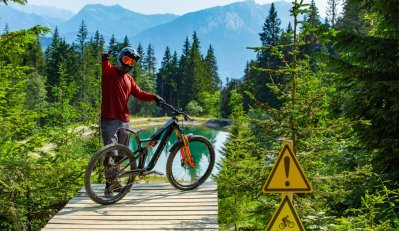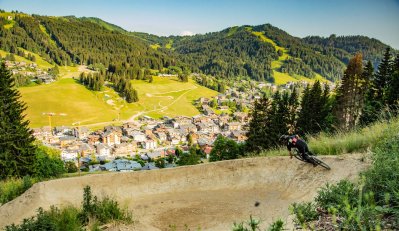The thing with Morzine is, you’re going to be pushing yourself. Unless you live in the Alps or at the foot of a bike park somewhere else in the world, it’s unlikely you come across 30 meter root sections, relentless, jagged rock gardens or trails you’d struggle to walk down. Even if you do it's probably not lift assisted with the opportunity to get 20 or more laps in a day for the whole holiday and add to that you'll be riding all day, everyday! It's the best time ever, but it's hard work!
Some arrive in the Portes du Soleil having prepped meticulously for their trip, and others arrive having not even cleaned their bike since the last trip. New tyres, pads, grips, bled brakes, nice new gear cables, new riding kit.
Often ignored is suspension, how many regularly have their kit serviced? How many really know what those dials actually do? Open? Closed? More? Less? How does that relate to your riding? Hopefully, you’ve had suspension tuned or serviced by the good folks at Mojo before your trip, unless you're already a dab hand yourself. If not, or even if you have, a basic understanding of how to adjust your equipment to suit your riding and the trail, is useful, to enhance your experience.
What do all the adjustments, dials and spacers do and they are used for different kinds of terrain around Morzine, Les Gets, Chatel, Morgins, Champery and the Portes du Soleil?
Aside from the idea of using harder or softer springs, more or less air, or volume spacers if your platform has that option, this blog runs through the dials on your suspension. Morzine and surrounds are best suited to a progressive setup, soft at the top and getting firmer at the bottom, so bring a volume spacer or two to add in if you start blowing through your travel too quickly. For example, if your dials are not making a notable difference, letting out a few psi of air, and adding in a volume spacer, can help the initial travel become softer, easing the impacts on your body and increase grip, but will prevent harsh bottom outs. With coils this is a little more tricky to get tuned as you'll potentially need springs to change out, but the dials still work in the same way.
Sag and basic setup
None of the below will not work out making much of a difference unless you have your sag setup correctly. Your bike will have recommended settings, usually somewhere around 15 - 20% of full travel. Getting this setup is really important, you need to start from a balanced platform between front and rear or you will end up in a hole of confusion and squishy doubt.
Who better to get you dialled than Jordi?
SUSPENSION SETTINGS
Not all components will share the same dials, you can only setup what you have, if's it's a modern bike, it'll have plenty enough adjustments to get you going.
Preload
This effects the sag on your forks, via the spring, so the more preload you run (plus = closed, or clockwise for more preload), the less your suspension will sag when you sit on the bike, or are riding.
Where to use it?
Relevant if your blowing through travel, or find your weight pitched over the front of the bike on hard pack berms or rider related movements such as hard pedaling, the more plus clicks, the higher your suspension will sit.
Compression
This is how hard or soft your suspension is through it’s travel, some components will have the option to adjust High and Low Speed (HSC & LSC).
High Speed Compression
This effects the way your suspension moves over hit at a high speed, not you, but the movement of the suspension unit itself. So there are generally these are trail obstacles or drops. More clicks to plus (clockwise/closed), the harder it will be when the suspension is moving faster. This does not necessarily give you a more progressive feel (where your suspension ramps up and becomes firmer toward the end of the travel), but it would help you stop blowing through travel. Thinking of it like turning a tap on or off, which in your fork or shock, is allowing or slowing the flow of oil.
Where to use it?
High Speed impacts on the trail are big hits. Drops, landings, big braking bumps, big root or rock sections where you are using over 50% of your travel. Morzine’s black mainline, Chatel’s Air Voltage, or Super Morzine’s Hattock are where you consider winding some of this on. For Morzine and the Portes du Soleil in general, It's very important to balance you comfort and performance. It's good idea wind high speed compression to afew clicks from open, and turn it in if you feel you are getting through your travel to quickly.
Low Speed Compression
These are the rider effected impacts at the top and middle of the travel, so things like berms, g-outs, small braking bumps, roots. The suspension component is moving slower. This adjustment is one of the most helpful in transitioning from UK riding to the Alps. Typically, in Britain you’d run this setting somewhere in the middle to closed (clockwise, or plus). We’d advise in Morzine to start off opening it out afew clicks from fully open. Then as you adapt after the first few days, gradually close it off.
Where to use it?
Super Morzine’s trails under the lifts, Chavannes and Nauchettes in Les Gets aswell as runs like Serpentine in Chatel are where you should really pay attention to you LSC when arriving in town. Also trails with plenty of root sections such as Canyon in Les Gets or Champery’s infamous World Cup track
Fox Float X2 has plenty of options to tune for your Morzine holiday
Rebound
This controls how fast, or slowly, your suspension recovers to it’s normal position. Most suspension models will have only a faster (minus/open) and slower (plus, or closed) rebound setting. The difference between LSR (low speed rebound) and HSR (high speed rebound) is below. However very few platforms have this option, so consider them both as the same for forks or shocks without the difference.
High Speed Rebound
In essence, the same as High Speed Compression, however rebound is very important in the Alps. It is used to control how fast your suspension recovers from big, consecutive hits. You want to run this as fast as you feel comfortable with, if your shock can’t recover in time from one hit to another, the shock, or fork, will pack up and not be ready for the next impact.
Where to use it?
Trails like Pleney’s black mainline, Nico Vink’s new signature trail in Chatel or Mont Chery’s Gets Airline are notable for their big hits, big jumps and multiple hard compressions in a row. Open (minus, faster) your High Speed Rebound as much as you feel comfortable with. Be careful to ensure you are happy with it’s speed lifting or the face of a jump, to ensure you are not getting bucked off the lip.
Low Speed Rebound
This dictates how your fork or shock recovers from rider related, or small hits, returning from the initial 50% of the travel or less. This is very important for recovery on persistently braking bumps or roots, and is especially useful for grip. To stop your suspension binding, or packing up in the travel (not recovering and blowing through it’s stroke). you need more rebound, so wind the dial afew more anti-clockwise (minus/open) of your struggling with grip or getting a harsh ride on the bumps.
Where to use it?
Tracks such as Chavannes mainline in Les Gets, or the red track in Morzine, with it’s persistent stutter bumps are a great place to feel this setting work, if you need need more rebound, wind the dial afew more anti-clockwise (minus/open) of your struggling with grip or getting a harsh ride on the bumps.
Rebound note
As a general thought process, think to set your rebound in the Alps as fast as you feel happy with, the sheer amount of impacts that your suspension needs to recover from is vastly different from most places in the world, so it needs to recover to keep you planted with grip, and keep your hands healthy.
Get that suspension service booked in before your holiday in Morzine here: Ride Fox UK
We can also offer assistance to our clients with our in house mechanic during your trip! We can service and supply parts for Fox 36 and 40's excluding damper cartridges. we can perform fork lower and air can services in house, but anything damper related you should arrange t be serviced before departure.
Is your bike and suspension fit for the job?
Morzine is not easy on bikes or suspension that's why we have gone with the best suspension and heavy hitting enduro bikes you can buy, Specialized Enduro's the number one choice for single crown bikes found in any bike park for good reason! If you want to avoid broken bikes, expensive parts and down time then book a bike a hire bike from MTB Beds.
To book your holiday in Morzine check the links below!





